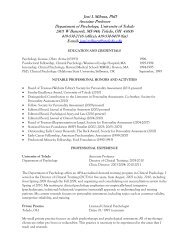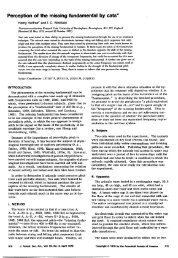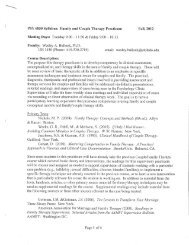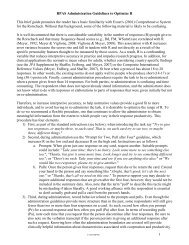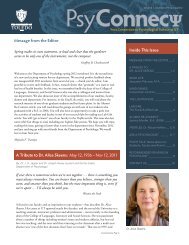The Rorschach Rating Scale: Item Adequacy, Scale ... - Psychology
The Rorschach Rating Scale: Item Adequacy, Scale ... - Psychology
The Rorschach Rating Scale: Item Adequacy, Scale ... - Psychology
- No tags were found...
You also want an ePaper? Increase the reach of your titles
YUMPU automatically turns print PDFs into web optimized ePapers that Google loves.
226 MEYER, BATES, GACONOemotional states (e.g., <strong>Scale</strong> 8 of the MMPI), whereas others measure more focusedpsychotic characteristics (e.g., the RRS Formal Thought Disorder scale).Second, even though several researchers have attempted to integrate models ofnormal personality with clinical models of psychopathology (e.g., Clark et al.,1996; Watson, Clark, & Harkness, 1994), most factor analytic studies have reliedon self-ratings from nonpatients to generate data. We are not aware of any studiesthat have used expert clinician ratings as the factor analytic input to determine howmore disturbed symptomatology fits within the B5M. Given this gap in the literature,some studies may have found strong associations between N and psychoticcharacteristics because the raters who generated scores did not have a sufficientlysophisticated understanding of the characteristics under consideration. To the extentthat lay raters have an undifferentiated or skewed understanding of certain aspectsof personality, this should influence the correlation among traits andsubsequent factor analytic solutions.Finally, for factor analytic studies, the prevalence of psychotic items (or scales)in the variable matrix may largely determine whether psychotic processes define aunique dimension of personality. This is because the content emphasized in ananalysis determines the presence and size of the factors that will eventually be extracted(Block, 1995; Gorsuch, 1983). This phenomenon accounts for some disparitiesobserved in this study. When the 176 RRS items were factored alone or incombination with the five B5M scales, the variable matrix contained a relativelylarge proportion of psychotic items and the data produced a clear factor of psychoticprocesses that did not receive strong loadings from N. However, as the proportionof psychotic level symptomatology in the variable matrix was reduced, thefactor structures reflected this decreasing emphasis. When the number of markervariables for psychotic content was trimmed but not trivialized, as it was when the19 conceptually derived RRS scales were factored with the 50 B5M items (Table4), then the psychotic content was “squeezed” to fit on a redefined neuroticism dimension.Alternatively, when psychotic processes were represented by just a singlescale in a matrix of more than 50 variables, as it was when the six RRS factorscales were examined with the 50 B5M items (Table 3), then the construct of psychosisno longer played an important role in the factor output.Models of normal personality (e.g., Costa & McCrae, 1992b; Goldberg, 1990;McCrae & Costa, 1997; Tellegen, 1996; Wiggins, 1979) have not provided muchdefinition for psychotic characteristics. However, clinicians have historicallymade important diagnostic and treatment-related distinctions between classicneuroticism traits such as dysphoria, anxiousness, or inadequacy, and more severepsychotic operations such as the loss of ego boundaries, thought disorder, perceptualdistortions, projective identification, massive denial, or splitting (e.g., AmericanPsychiatric Association, 1994; Blatt & Blass, 1990; Gabbard, 1990). Toresolve the place of psychotic symptoms within a complete taxonomy that spansnormal and abnormal personality, not only will researchers need to gather ratingCopyright © 2000 All Rights Reserved



